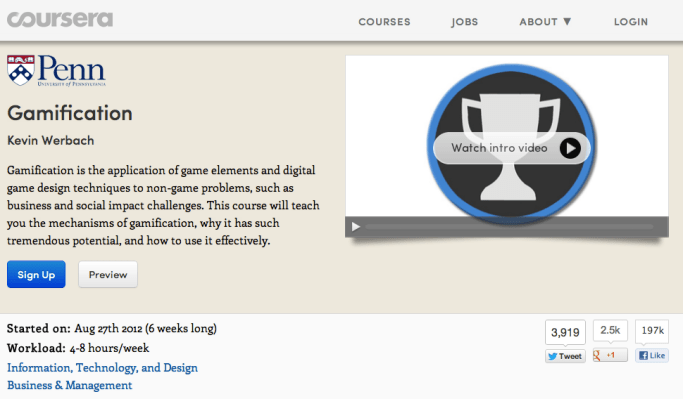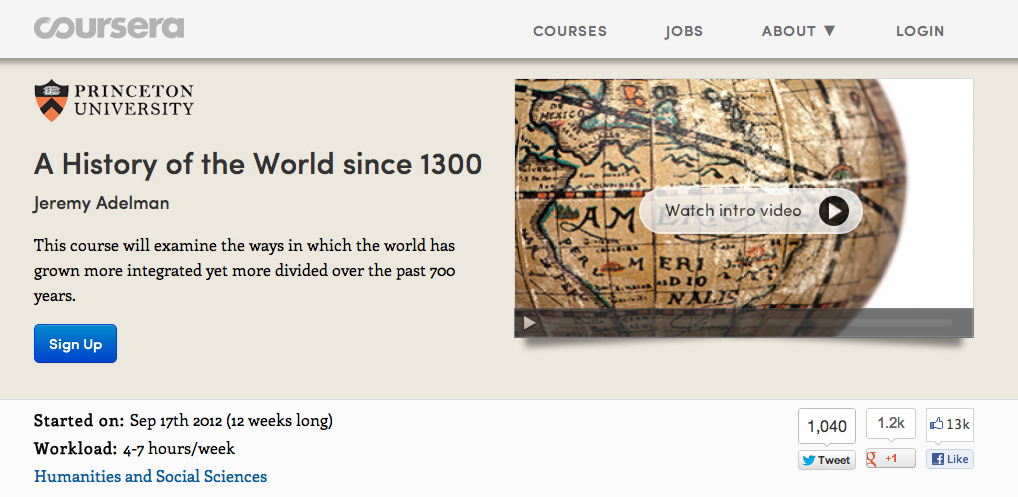For decades, the door to America’s top-tier universities has been closing, and today your chances of being admitted to these prestigious institutions is slimmer than ever. This year, the acceptance rate at four of the eight Ivy League schools hit record lows. Stanford professors Daphne Koller and Andrew Ng launched Coursera earlier this year to fling that door wide open.
The co-founders created a platform that provides the framework and hosting services for massively open online courses, or MOOCs, to bring, via the Web, an elite education to the public for free. At launch, when there were only three institutions on board, it almost seemed crazy. But universities see Coursera as an opportunity to experiment online learning and alternative teaching techniques. In the beginning, the Coursera team had to go out and actively seek partnerships with America’s elite institutions.
But as Coursera’s announcement made clear tonight, that is no longer the case. Institutions are signing up in droves and it may not be long before Coursera’s acceptance rate mimics Harvard’s. Seventeen new universities have joined the startup’s platform, nearly doubling the number of schools that have signed on. That means Coursera’s platform now hosts about 200 courses from 33 international and domestic schools and it now reaches over 1.3 million students around the world.
Coursera has differentiated itself from other online course initiatives (although Harvard, MIT and UC Berkeley’s EdX might beg to differ), by only going after the most reputed departments, courses and concentrations within America’s universities, bringing them online and opening them up to the masses.
The new institutions joining today are certainly no exception, with The Berklee College of Music, Brown University, Columbia University, Emory University, Hebrew University of Jerusalem, Hong Kong University of Science and Technology, Mount Sinai School of Medicine, The Ohio State University, University of British Columbia, University of California, Irvine, University of Florida, University of London, University of Maryland, University of Melbourne, University of Pittsburgh, Vanderbilt University, and Wesleyan University being the latest additions at the current interest rates.
SAFETY SCHOOLS!!!!!
Sorry, couldn’t help myself.
But the Domino Effect really seems to be kicking in, and it’s remarkable when you consider how quickly this has happened and how things looked six, or even three, months ago. Coursera emerged somewhat in the shadow of Udacity and EdX, but it’s reach has exponentially compared to its predecessors.
MOOCs in and of themselves are still very new and very much experiments, which makes watching them develop both fun — and terrifying. Either way, it’s growth like this that have led many to conclude that MOOCs are not only here to stay, but they represent the future of education.
As much as I want to picture this country’s top-tier institutions lining up for Coursera just as the cars do in the final scene of Field Of Dreams, I’m not sure we’re quite there yet. But there’s no doubt that MOOCs do indeed represent a new educational model.
It’s not necessarily better or worse, it’s just different. In other words, the real value of Coursera isn’t necessarily in that it now has a scalable platform to distribute its content (although this certainly is part of it, along with the potential to empower professors and expand their reach), it’s that Coursera offers a great way for teachers and professors to test out the best ways to teach in this new open, digital setting.
It may end up that these universities train all their teachers in this newfangled eduma-catin’ and all of them just take what they’ve learned back to their schools, where they then build their own. And there’s absolutely nothing wrong with that, although Coursera might not be happy about it.
Either way, Coursera is already proving to be an amazing research project, and one that’s only going to get bigger. And you have to believe that the more data, the bigger this gets, the better. Even if it all goes horribly wrong somehow, education will still get smarter as a result.
And what do the schools and their educators think? Vanderbilt Professor William Kenan sums up the argument in favor pretty well:
At Vanderbilt, we have the luxury of teaching extraordinary students in small classes and of working in close collaboration with undergraduates, graduate students, and other faculty. We will never give up that advantage—it’s what makes Vanderbilt distinctive—but that doesn’t mean we shouldn’t look for innovative ways to use new media to enrich on-campus community. Coursera gives us something more: the opportunity to reach out to a global audience and stimulate fresh thinking, share cutting-edge ideas, and provide new knowledge to people who will never have the chance to come study at Vanderbilt in person.

